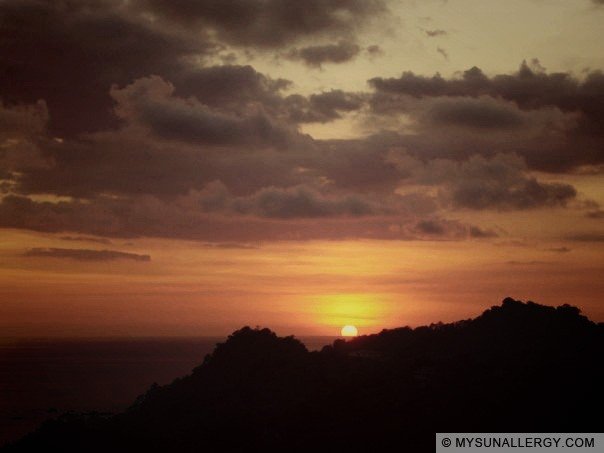What is PMLE?
Polymorphous light eruption (PMLE), otherwise termed Polymorphic light eruption (PLE), is a skin complaint caused by sunlight, which usually appears as an itchy rash on sun-exposed skin. It is the most common sun allergy, affecting people of all ethnic backgrounds. In temperate climates (4 seasons), PMLE is common during the spring and summer months.
It is called polymorphous or polymorphic because it can take many different forms. The skin rash and the appearance of the eruption can be different for every person it affects. A dermatologist can help determine if you are affected by it.
Typically, the rash develops at the beginning of the summer when you expose your body to sunlight for the first time. It is quite common for Americans and Canadians to have a winter escapade in March and April; PMLE can also develop during this time if skin is exposed to sunlight. Those affected by the condition are usually exposed to the sun for two to three days while on holiday, although sometimes as little as 15 minutes of exposure can induce the condition. The amount of sun exposure that will develop a rash and serious symptoms will vary.
The skin rash usually consists of small red spots or blisters that can appear on any part of the body that has been exposed to sunshine, except the face and back of the hands. It may take between 5 to 10 days to clear, even longer if skin is still being exposed to sunlight.
As the season progresses, the person becomes less sensitive. The skin adjusts to this effect of the sun, which is called “hardening”. Any kind of sudden or intense exposure to the sun can spark PMLE again. A typical scenario in the winter is when patients from Northern climates go to the Caribbean.
As studies have shown (Richards et al), PMLE engenders a substantial psychosocial impact on patients who have the condition. Patient experienced emotional distress linked to PMLE.
Who suffers from PMLE?
In North America, studies show that approximately 10% of the population is affected by Polymorphous Light Eruption (PMLE). In some parts of Europe, like Sweden, it can affect nearly 20% of population. Women are affected by PMLE more often than men and symptoms typically emerge during young adult life.
PMLE can affect all ethnic groups, but in North America, prevalence is slightly higher for African Americans. Some Native Americans also have a hereditary form of PMLE (also called Actinic prurigo), which tends to be more severe. Studies suggest that 20% of patients have a family history. Those who suffer from PMLE usually see symptoms develop by the age of 30. Many patients find that the complaint clears up spontaneously. PMLE also tends to improve for women after the menopause.
PMLE causes and diagnosis
Causes of PMLE are not completely understood. It’s thought by some experts that it may be an allergic reaction following the interaction of sunlight with proteins in the skin.
Unfortunately, PMLE is not seriously considered despite the fact that it affects a lot of people. The reason is that it can be easily prevented by avoiding sunlight and wearing proper clothing. You usually do not end up on a beach against your will wearing a bikini. We can all agree, it is typically far from a life threatening condition.
But for those it affects, it could limit lifestyle in the summer months and particularly during the holidays by inducing many restrictions. Severe cases may cause significant problems that require more active therapy than simply avoiding the sun. With time, most patients get to know their skin and are able to determine how much sunlight exposure they can tolerate.
A dermatologist is normally able to diagnose PMLE from a patient’s story. Should there be any doubt, your doctor will rule out other causes of abnormal skin sensitivity to light (photosensitivity) with blood tests and phototesting.
If the eruption disappears by itself 2 hours after covering up, you may be suffering from another form or sun allergy. Lean more about Solar urticaria and photoallergic eruption symptoms here.
How can you prevent PMLE?
Beach lovers may de disappointed to hear this, but many patients find that they can prevent the condition by wearing protective clothing, avoiding the sun between 11am and 3pm, and frequently applying a broad-spectrum, high-SPF sun protection. Preventive therapy, what doctors call “prophylactic therapy”, is a line of action that, although effective, restricts one’s lifestyle during the summer months or winter vacation.
Another way to prevent severe PMLE is to undergo a course of desensitization treatment. The patient goes into a phototherapy cubicle where those parts of the body that are normally kept covered become exposed to ultraviolet light. The ultraviolet exposure is gradually increased, thereby increasing the skin’s natural sunlight protection. Desensitization is normally conducted in early spring and, since the effect is usually completely lost during the subsequent winter, needs to be repeated annually. This kind of therapy is time consuming and expensive. It is not available in all countries but might be used for extremely severe case of PMLE.
Some patients experience great success doing their own therapy in tanning beds 3 weeks prior to vacation. The most important factor is to gradually increase the exposure to cause hardening, which means the skin gradually get used to sunlight. Most tanning beds emit mainly UVA rays, which may increase the risk of skin cancer. It also means that tanning sessions might not even induce PMLE since the UVB proportion is lower than real sunlight. Because of the adverse effects on human health of overexposure to UV radiation, including skin cancer, cataracts, suppression of the immune system, and premature skin aging, the World Health Organization does not recommend the use of UV tanning devices for cosmetic reasons.
Concern by possible negative effects of tanning sessions on your skin? Alternative preventive treatments also include Beta-Carotene and nicotinamide tablets 2 to 3 weeks prior to vacation and everyday until hardening.
Oops too late to prevent, how can I treat PMLE?
Anti-ich preparation and cold compresses may produce some temporary improvement. You could also try calamine lotion or topical steroid creams. Some people experience improvement with oral antihistaminic. Aloe Vera may also help reduce the burning sensation. Occasionally, a doctor may prescribe antipaludic tablets, although this is usually avoided because of the possible side effects. Antioxidant body lotion containing Vitamin E might also help diminish inflammation of the skin. A new body lotion containing Glucosylrutin, a natural antioxidant, and vitamin E is also available.

